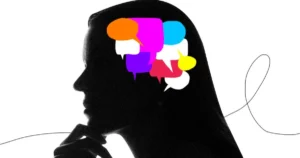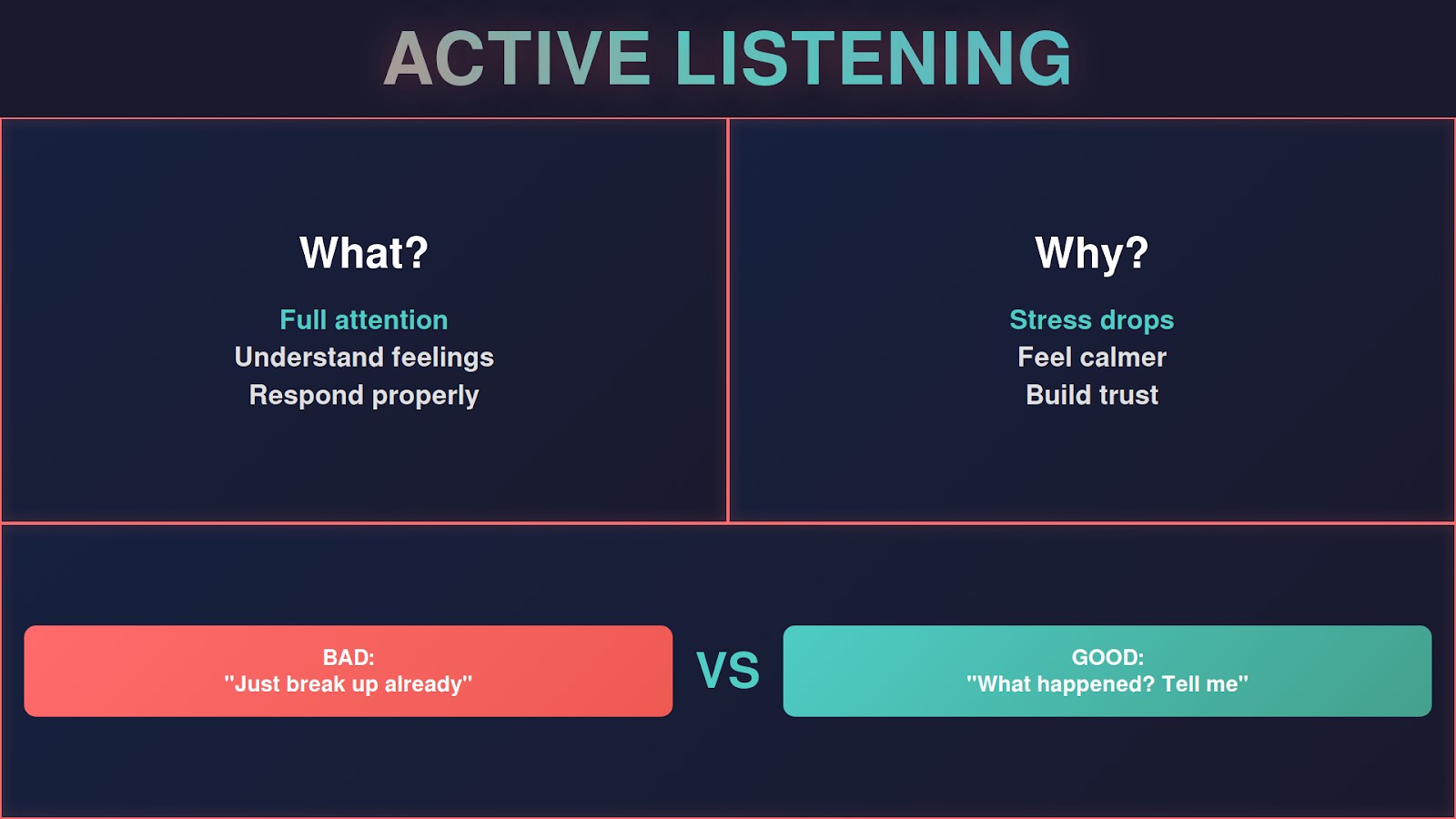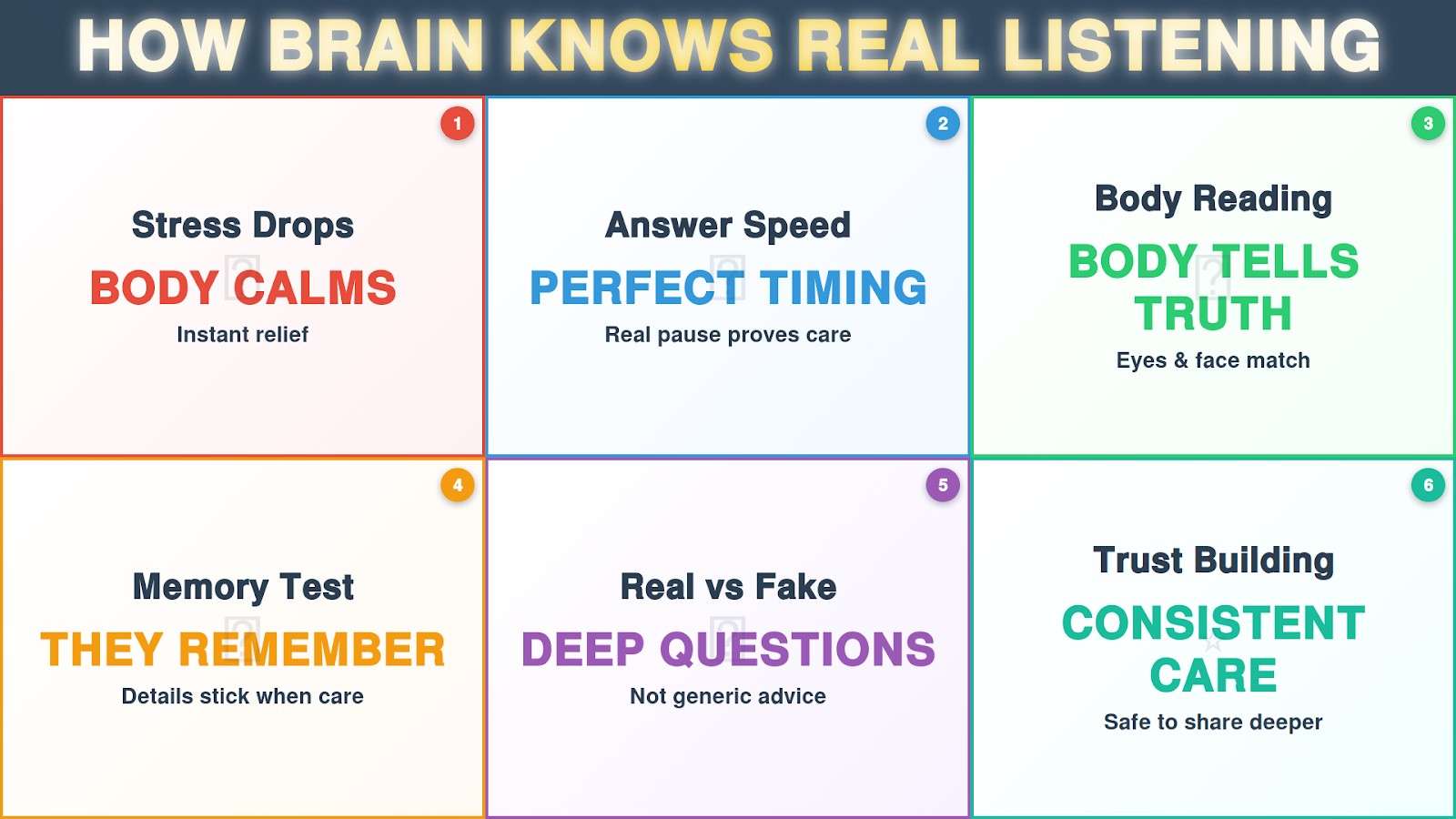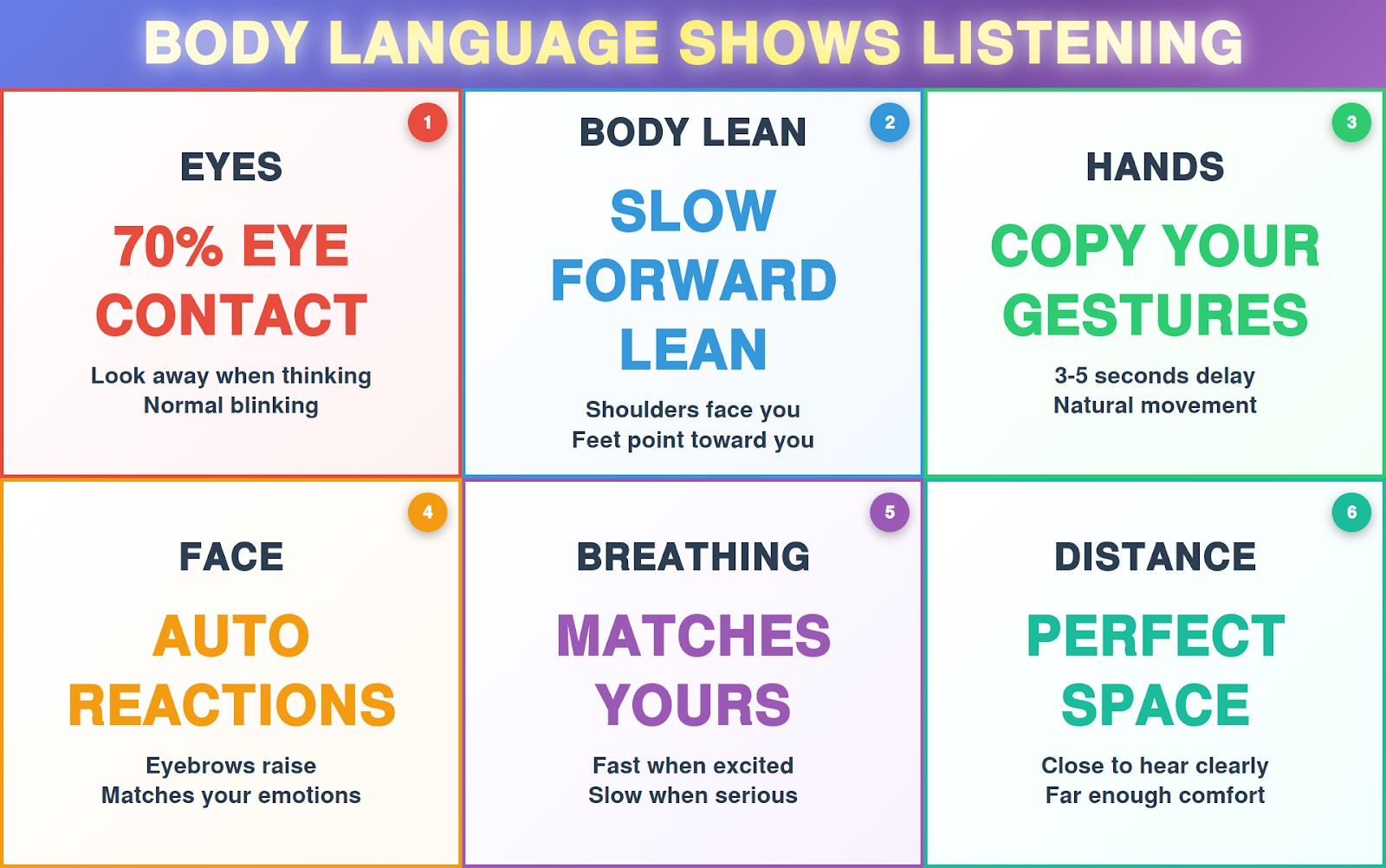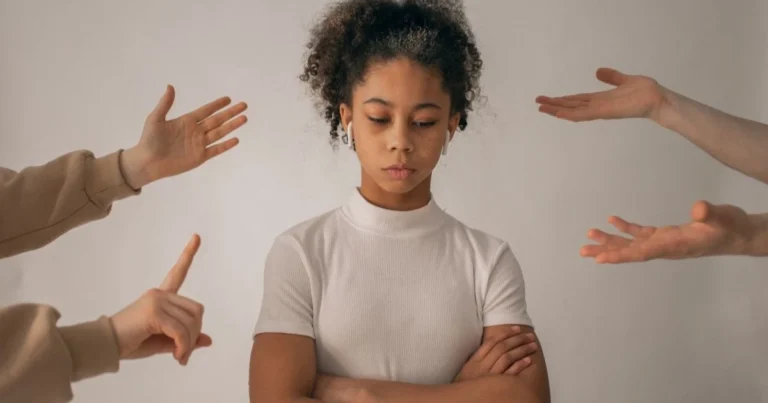You know how some people just seem to “get” what you’re saying while others act like they’re not even there? Good listening isn’t magic, and anybody can learn how to do it right.
Most people think listening means keeping your mouth shut, but there’s way more to it than that. Real listening uses your eyes, your hands, your face, and you even need to control what’s going on inside your head.
Also, people from different countries have totally different rules about what good listening looks like.
What Exactly Is Active Listening, and Why Should I Care if Someone Does It?
Active listening means someone pays full attention to you when you talk. They understand your words and feelings, then respond in ways that show they really get what you mean.
Graham Bodie says active listening has three parts:
- Sensing your emotions
- Processing what you actually mean
- Responding properly.
Most people just wait for their turn to speak instead of really listening.
- Bad listening: You call your mom crying and say, “I had a fight with my boyfriend.” She cuts you off and says, “You two always fight, just break up already.” She doesn’t ask what happened or how you feel.
- Good listening: The same scenario, but she says, “Oh, honey, what happened? Tell me everything.” She listens to your whole story without interrupting. Then she says, “That must have really hurt when he said that to you. No wonder you’re upset.”
What Happens in Your Brain When Someone Really Listens?
Your stress drops immediately when someone truly hears you. Davorka Topić Stipić explains that feeling heard reduces anxiety and builds trust between people. So active listening triggers positive changes in your body:
- Your stress hormones decrease
- You feel calmer and more relaxed
- Your confidence grows
- You trust the other person more
Red Flags of Fake Listening
François Schellevis warns about people who pretend to listen but don’t really care:
- They interrupt constantly
- Give quick advice without understanding the problem
- Their responses don’t match what you said
- They forget what you told them later
How Does My Brain Know When Someone Is Really Listening to Me?
Your brain has special ways to figure out if someone truly cares about what you say. In fact, it picks up signals you don’t even notice.
1- Your Stress Goes Down Fast
Sachiko Mineyama checked 203 workers and found that people with good listeners as bosses felt way less stressed.
When you call your sister crying about work, her reaction changes how your body feels:
- She keeps typing on the computer = your heart stays fast
- She stops working and asks, “What happened?” = you feel calmer right away
Your brain knows the difference. Akizumi Tsutsumi says that when someone really hears you, stress chemicals in your body drop quickly.
What happens in your body:
- Shoulders relax
- Breathing slows down
- The heart beats normally
- Face muscles soften
2- Speed of Answers Tells You Everything
People who fake listening answer too fast since real listeners need time to think about what you said.
You tell your friend, “I’m scared about the test tomorrow.” Quick fake response: “You’ll be fine!” But a real listener pauses and asks, “What part scares you most?”
Soshi Takao found that timing matters a lot:
- Too fast = they planned their answer while you talked
- Just right = they heard you and thought about it
- Too slow = they weren’t paying attention
Think about when your mom asks how school was. If you say “terrible” and she immediately says “at least you went,” she wasn’t really listening. But if she stops and asks, “Why was it terrible?” that pause shows she heard you.
3- Your Brain Reads Their Body
Someone can say they’re listening, but their body tells you the truth. Scott Bishop explains that your brain automatically checks these things without you knowing:
Body signals your brain notices:
- Eyes: Do they look at you or around the room?
- Hands: Are they still or fidgeting with their phone?
- Face: Does it match how you feel?
- Body position: Facing you or turned away?
When you’re upset about breaking up with your boyfriend and tell your dad, a caring dad’s face looks worried, but a distracted dad keeps the same blank face. Your brain catches this right away.
4- Memory Proves They Care
Your brain keeps track of who remembers what you shared. Humaira Jami worked with 73 doctors and found that patients immediately knew which doctors really cared.
Last week, you told your coworker you were worried about your sick cat. This week, if they ask, “How’s your cat doing?” your brain thinks, “They actually cared enough to remember.”
Memory test your brain does:
- Do they ask about things you mentioned before?
- Do they remember details or just big stuff?
- Do they bring up your problems without you saying anything?
5- Real Understanding Versus Fake Responses
Your brain tests if people actually “get” what you mean. Rachel Reznik found that people who are good listeners have fewer health problems.
You tell someone, “My boss is driving me crazy.” Fake listener says, “All bosses are annoying,” but real listener says, “What does he do that bothers you?”
Michael Roloff discovered the difference:
| Fake Understanding | Real Understanding |
|---|---|
| Generic comments that fit anyone | Specific questions about your situation |
| Quick advice without asking more | Wanting to hear the whole story |
| Making it about them | Keeping focus on you |
When your friend says their girlfriend broke up with them, a fake listener immediately shares their own breakup story, but a real listener asks, “How are you handling this?”
6- Trust Builds Over Time
Courtney Miller says your brain tracks patterns over many talks. Each good listening experience adds points:
- They remember what you said last time
- They ask follow-up questions that make sense
- Their face shows they understand your feelings
- They don’t judge or give quick fixes
When your brother consistently listens well, your brain relaxes around him. So you naturally share deeper stuff because your brain learned it’s safe—this is part of how we go from confusion to clarity in relationships, as explored in Unmasking Your Inner Critic.
What Words and Sounds Tell Me Someone Is Listening?
Your ears pick up clear signals when someone truly pays attention. These sounds and words prove real listening better than any fake smile.
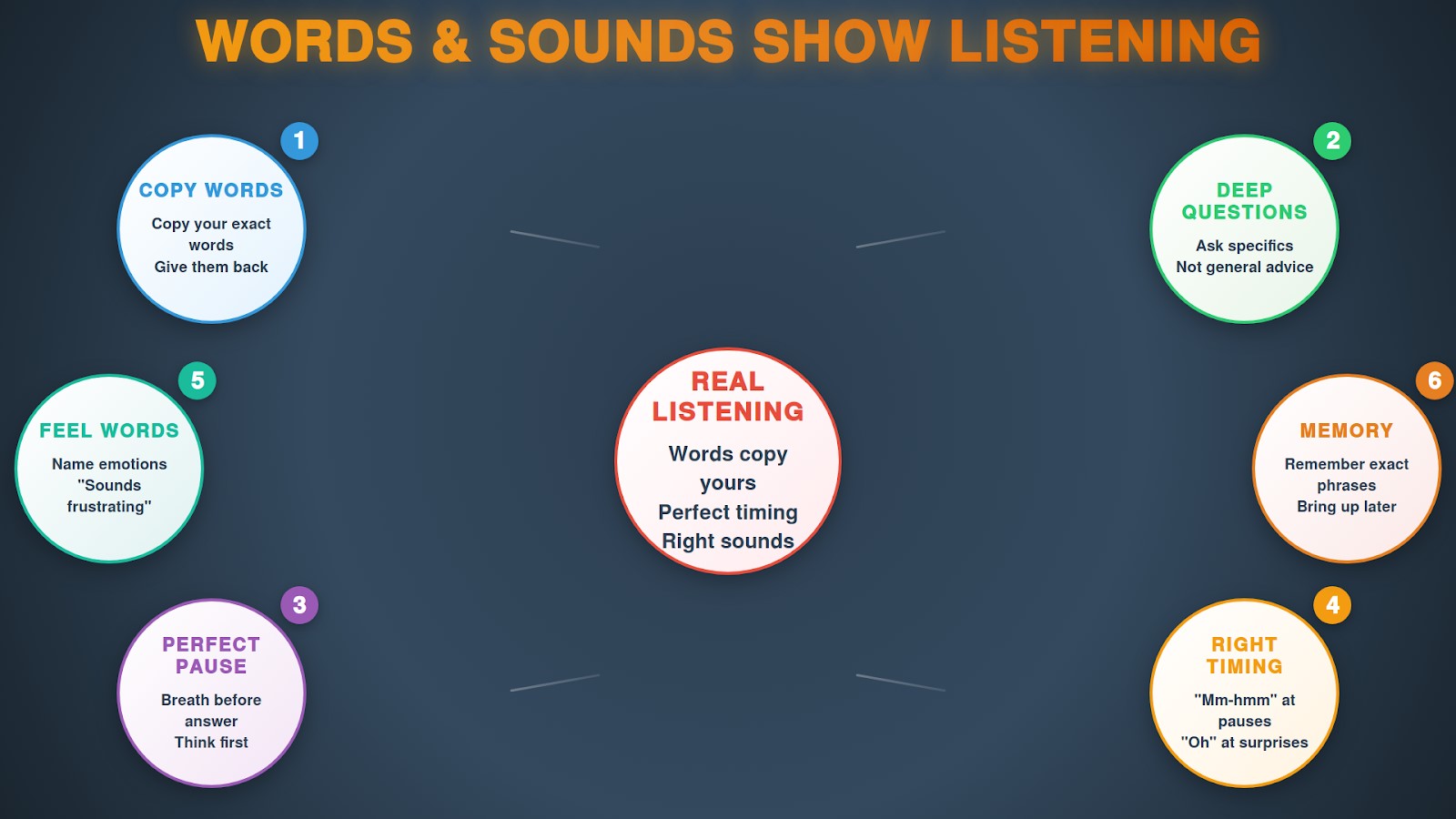
1- Words That Copy Yours Exactly
Real listeners grab your specific words and give them back. Harry Weger tested this with 180 students and saw that people liked listeners more when they heard their own words repeated.
For example, you say, “I’m worried about money.”
- A fake listener: “Everything will work out.”
- Real listener: “So you’re worried about the money situation?” They used your exact words, “worried” and “money.”
Copy patterns that prove listening:
- “What I’m hearing is…”
- “So you’re saying…”
- Using your keywords back at you
- Repeating your phrases in their response
2- Questions That Dig Into Details
Good listeners ask about specifics, not general stuff. When you mention fighting with your roommate, they don’t ask, “Why don’t you move out?” Instead, they ask, “What did she do that made you mad?”
| Surface Questions | Deep Questions |
|---|---|
| “Have you tried talking?” | “What exactly did she say?” |
| “Why worry about it?” | “What part worries you most?” |
| “Things happen.” | “How did that make you feel?” |
3- Pause Before They Talk
Sandra Spataro teaches people to listen better and noticed something important; good listeners take a breath before answering. This pause isn’t awkward. It proves they thought about your words first.
When someone responds instantly, they have planned their answer while you were talking. Real listeners need that moment to process what you said.
4- Small Sounds at the Right Time
Listen for tiny sounds that happen exactly when you finish a thought: “mm-hmm,” “oh,” “right.” Janel Bloch found that these keep conversations flowing naturally.
Your sister makes these sounds right when you pause or complete an idea. Distracted people either stay totally quiet or make sounds at weird moments that don’t match your talking rhythm.
Good timing sounds:
- “Uh-huh” when you pause
- “Oh,” when you share something surprising
- “Right,” when you make a point
- Silence when you need to think
5- Feeling words you didn’t say
Patricia Warrington uncovered that active listeners name emotions they hear in your voice, even when you don’t directly mention feelings.
You complain that your boss “keeps changing deadlines,” and they respond, “That sounds really frustrating.” You never said “frustrated,” but they caught the feeling behind your words.
Real listeners translate your situation into emotions:
- “That must be exhausting.”
- “How annoying.”
- “That sounds scary.”
- “You seem really happy about this.”
6- Memory for your exact phrases
Sheila Shipley points out that caring listeners store your specific words and bring them up later. You mention feeling “overwhelmed” early in the conversation. Twenty minutes later, they say, “You talked about feeling overwhelmed – is that still happening?”
This proves they filed away your exact language, not just the general topic. Fake listeners forget your specific words and only remember broad ideas.
What Should I Watch for in Their Body Language?
Body movements tell you who really listens and who just pretends.
1- Eyes Show Real Attention
People who truly listen look at your face about 70% of the time. Michael Argyle spent years watching how people look at each other during conversations and found that real listeners keep steady eye contact but also look away briefly when they’re thinking about what you said.
Meanwhile, fake listeners either stare too hard or look everywhere except at you. Plus, real listeners blink normally, not too fast or too slow.
2- Body Leans Forward Gradually
When someone really cares about your words, their body slowly moves toward you. This happens without them even noticing. Ronald Riggio studied nonverbal skills and found that good listeners shift their weight forward when you share something important.
On the other hand, fake listeners either sit like a statue or lean backward like they want to escape. Real listeners also turn their shoulders toward you and point their feet in your direction.
| Real Listening | Fake Listening |
|---|---|
| Slow forward lean | Stays rigid or leans back |
| Shoulders face you | The body turned sideways |
| Feet point toward you | Feet point away |
| Open chest | Arms crossed |
3- Hands Copy Your Movements
Watch their hands while you talk. Real listeners automatically copy your hand gestures about 3-5 seconds after you make them. You wave your hands while explaining something, and they start moving their hands in similar ways.
Mark Cook discovered that this copying happens naturally when people connect. In contrast, fake listeners keep their hands in the same spot the whole time or fidget with random stuff.
4- Face Changes Automatically
Real listeners’ faces react without them controlling it. Their eyebrows go up when you share surprising news, and their mouth opens a bit when you describe something shocking. Sandra Spataro teaches people to spot these tiny face changes because they prove a genuine emotional connection.
Automatic face reactions:
- Eyebrows raise during surprising parts
- Your mouth moves with your emotions
- Forehead wrinkles when concentrating
- The face relaxes during calm moments
5- Distance Feels Comfortable
Finally, real listeners position themselves at just the right distance. They stay close enough to hear everything clearly but far enough that you don’t feel crowded or uncomfortable.
Hooman Motevalli explains in his CCC training that good listeners need clear mental space first before they can create good physical space.
When your inner voice keeps chattering and judging, you can’t focus on the other person properly. This mental noise makes you either get too close (trying too hard) or stay too far away (wanting to escape).
But when someone trains their inner voice to stay quiet, they naturally find the right physical distance.
Physical space connects to mental space:
- Quiet inner voice = better distance judgment
- Mental chaos = wrong physical positioning
- Clear mind = natural body placement
- Inner training = outer comfort
Space management basics:
- Stay close enough to hear clearly
- Keep far enough to avoid crowding
- Adjust when the other person moves
- Don’t invade space during emotional moments
Does Active Listening Look Different in Different Cultures?
Yes, listening rules change big time from place to place. What your mom taught you about good listening might upset someone from another country. So you need to know what actually works where.
Americans and Europeans Want To See You Care
Janneke van de Pol discovered that Western teachers become concerned when students remain too quiet. They think quiet means you’re not paying attention or maybe you’re bored.
Do this stuff:
- Look right at their eyes most of the time
- Nod when they say something important
- Move your body closer to show you care
- Jump in with questions right away
- Make little sounds like “uh-huh” while they talk
Asian people Prefer You Stay Calm and Respectful
But then Monique Volman noticed something totally different with Asian students. All that head nodding and eye contact? It comes across as fake or even rude to them.
Try this instead:
- Look down sometimes to show respect
- Keep your body really still
- Wait for them to completely finish before you say anything
- Give a small bow when they’re done talking
- Stay mostly quiet while they speak
Middle Eastern People Mix Warm and Formal
Also, Jos Beishuizen found that Middle Eastern cultures do this interesting thing. They want you to be friendly but also very respectful at the same time.
| Good Moves | Bad Moves |
|---|---|
| Some eye contact | Staring too much |
| Sit up straight | Slouch around |
Nordic People Actually Like Quiet Time
Plus, Sanna Ala-Kortesmaa spent time with people from Finland and Sweden. Turns out they don’t freak out when nobody talks for a while. They actually think it’s nice.
What works here:
- Don’t panic when it gets quiet
- Stop trying to fill every silence
- Keep your body relaxed during the quiet parts
- Take your time before you answer
- Show them you’re okay with waiting
Latin Americans Want Energy and Warmth
Meanwhile, Kris Acheson explains that Latin cultures are the complete opposite. If you’re too quiet or distant, they think you don’t like them or you’re being cold.
Better approach:
- Stand closer than you normally would
- Let your face show more emotion
- Give quick little responses like “yeah” or “right”
- Match their energy – if they’re excited, you get excited too
- A light touch on the arm is usually okay
African Cultures Think About the Whole Group
Similarly, many African cultures don’t just focus on you and the other person. They care about how your conversation affects everyone around you.
Remember to:
- Think about who else this conversation matters to
- Show extra respect if they’re older or in charge
- Use words like “we” instead of “you”
- Ask about their family or community connections
- Don’t make them pick sides between different people
FAQs
How long should I wait before responding when someone finishes talking?
Wait about 2-3 seconds before you start talking back. This short pause proves you’re actually thinking about their words instead of just planning what you want to say next.
Is it weird to repeat back exactly what someone just told me?
People actually love it when you use their exact words back to them. Just pick out the most important words they said and work them into your response naturally.
What if someone gets mad when I ask them to explain more?
Most folks actually want to share more details when you ask good questions. If they get upset, they’re probably stressed about something else, and it has nothing to do with you caring enough to ask.
Can I still be a good listener if I’m naturally a quiet person?
Quiet people often make the best listeners because they don’t feel like they have to jump in with their own stories all the time. Your natural silence actually helps you focus better on what others are saying.




